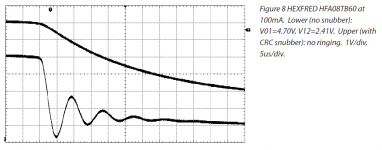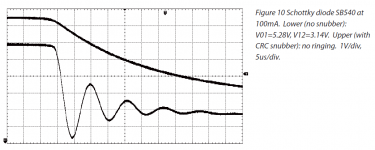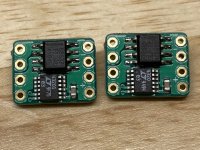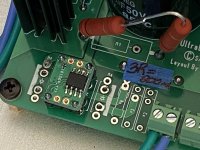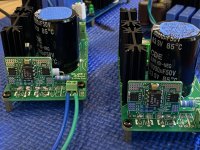In my case, my class A amp runs on a FWCT setup using SF3004PT diode. It only wastes 3 watts - it would hardly seem worthwhile to bother with AR in my case. Besides, why put AR and tubes (front end, output stage is MOSFET) into the same amp? It's like a double cheeseburger combo with a diet coke.
There is no relevance what these companies use in their product to DIY audio projects. That are two alternate Universes if you prefer. Even laws of physics are different. 🤣What type of rectifier is used in present-generation power amps currently shipping from Pass Labs?
What type of rectifier is in power amps currently shipping from Mark Levinson?
What type of rectifier is in power amps currently shipping from Luxman?
What type of rectifier is in power amps currently shipping from Dan D'Agostino?
What type of rectifier is in power amps currently shipping from Constellation?
What type of rectifier was used in (the ten most significant audio power amplifiers of all time)?
What type of rectifier is used in today's leading Class-D amps?What type of rectifier is used in present-generation power amps currently shipping from Pass Labs?
What type of rectifier is in power amps currently shipping from Mark Levinson?
What type of rectifier is in power amps currently shipping from Luxman?
What type of rectifier is in power amps currently shipping from Dan D'Agostino?
What type of rectifier is in power amps currently shipping from Constellation?
What type of rectifier was used in (the ten most significant audio power amplifiers of all time)?
I see what you are trying to achieve with that line of questioning, but it's a bit misdirective.
I have no ideea what sort of better perceived sound you get when hard switching mosfets in a stairs pattern,
It's a mystery to me too, as i have observed the PWM voltage at the mosfet's gate many times. But i have given up on arguing with my ears 🙂
This is how the needless arguements usually start on this forum. Ill only partake in it by going as far as say that youre being an absolutist when audio is both objective and subjective.
And this forum is called diyaudio and not diyelectronics, is it not?
And this forum is called diyaudio and not diyelectronics, is it not?
Meaning it hosts both electronics and crap?
Agreed.
But regardless, audio is still based solely on electronics and phisics laws.
None of which can explain why AR would provide for a better sound.
Besides, this attitude of yours is the main cliche when dealing with audiopile myths, you cannot explain it, you have no technical arguments, but you are absolutely sure you are right and everyone else is wrong and they sould try it...
Agreed.
But regardless, audio is still based solely on electronics and phisics laws.
None of which can explain why AR would provide for a better sound.
Besides, this attitude of yours is the main cliche when dealing with audiopile myths, you cannot explain it, you have no technical arguments, but you are absolutely sure you are right and everyone else is wrong and they sould try it...
Last edited:
Your words not mine.Meaning it hosts bot electronics and crap?
Agreed.
'A better sound quality MUST be proven with measurements.' This is also your words. I hope you come to see the ridiculousness of it soon.
I have seen enough crap on this forum, so yes, it does hosts bot high level electronics and myths ( IE crap ).
There is nothing wrong with the forum because of that, that's just how things are in real life.
Nothing ridiculous about what i said.
For years now, i design and built from scratch performance audio power amplifiers ( real measurable performance, not myths ), thus i do know what i am talking about.
Your problem is you just cannot acknowledge that audio is still only electronics, from the power supply to the driver coil.
What you perceive with your ears is subjective, not the amplifier it's self, and that is because of you, because of your knowledge, because of the invested money which MUST mean it's better ( one single example, tens of thousand of $ for a single signal cable, that's ridiculous but people still buy them ) , and mainly because of your own beliefs, none of them has anything to do with the performance of the amplifier it's self.
When music really sounds different it does so because some measurable difference in the audio system, either with the harmonics distribution, or the slew rate, or even the speaker cables them selves which if too thin they would have more DC resistance thus reducing the overall damping factor.
All of them are actual, measurable factors in the audio system, and all of them can influence the perceived sound.
The active rectifier on the other hand has no possible influence on any of them, it's job is solely to convert the alternating current in direct current, that's it, nothing else, the only variable is it's actual efficiency, and any eventual switching noise due to the mosfets switching between on and off, but that can be filtered or snubbed out, thus it cannot influence any of the amplifier's parameters.
There is nothing wrong with the forum because of that, that's just how things are in real life.
Nothing ridiculous about what i said.
For years now, i design and built from scratch performance audio power amplifiers ( real measurable performance, not myths ), thus i do know what i am talking about.
Your problem is you just cannot acknowledge that audio is still only electronics, from the power supply to the driver coil.
What you perceive with your ears is subjective, not the amplifier it's self, and that is because of you, because of your knowledge, because of the invested money which MUST mean it's better ( one single example, tens of thousand of $ for a single signal cable, that's ridiculous but people still buy them ) , and mainly because of your own beliefs, none of them has anything to do with the performance of the amplifier it's self.
When music really sounds different it does so because some measurable difference in the audio system, either with the harmonics distribution, or the slew rate, or even the speaker cables them selves which if too thin they would have more DC resistance thus reducing the overall damping factor.
All of them are actual, measurable factors in the audio system, and all of them can influence the perceived sound.
The active rectifier on the other hand has no possible influence on any of them, it's job is solely to convert the alternating current in direct current, that's it, nothing else, the only variable is it's actual efficiency, and any eventual switching noise due to the mosfets switching between on and off, but that can be filtered or snubbed out, thus it cannot influence any of the amplifier's parameters.
Putting aside any possible difference in sound (I will neither confirm nor deny any such difference 😀), I’m simply satisfied to have technically advanced solution in my build.
As for the explanation how could rectifier affect amplifier sound, interesting hint was given a few days ago here,
Every rectifier will produce wide harmonics spectra of primary 100/120 Hz. Those harmonics will end in the amplifier output attenuated by amplifier PSRR, and may be mayor distortion source at low signal levels, for an amplifier with a small PSRR.
Different rectifiers will produce different harmonics spectrum and there is theoretically possible source of perceived differences.
As for the explanation how could rectifier affect amplifier sound, interesting hint was given a few days ago here,
Every rectifier will produce wide harmonics spectra of primary 100/120 Hz. Those harmonics will end in the amplifier output attenuated by amplifier PSRR, and may be mayor distortion source at low signal levels, for an amplifier with a small PSRR.
Different rectifiers will produce different harmonics spectrum and there is theoretically possible source of perceived differences.
There was a monk once praying God that He will never allow him seeing angels because Lucifer was also an angel...Dreamth you strike me as more of a hands-on kind of a guy. Why not build a setup and listen?
Translation: I preffer hearing no bridge or any kind of rectifier's sound.Most of the times a better sound or heavenly tones hides some ringing or just some sort of compression...same as most of the music is actually crappy and I preffer listening to nothing instead.
Ok...the bridge efficiency is impeding class A efficiency ....go class D instead! I've heard Purify makes holly sounding audiophile class d amps.The only inefficient take ons there seem to be their amps prices...2% efficiency difference? Based on false setup “evaluation”!
LT4320 controller doesn’t produce “holly smoke” without PFC. LT4320 Datasheet
Real efficiency improvement is about 7% based om my case. My A class amplifier with active rectifiers consumes about 170 W with 3A idle current, both channels combined. Bridge rectifier will have 1V forward voltage, as a minimum, for actual pulse current charging capacitors. That would add minimum 6 W per rectifier (two diodes are conducting on each halfwave) or + 12W for both rails, if design was adjusted to maintain the same PS output voltage (+1V higher AC voltage per rail required). So, amp with standard rectifiers will consume 182 W or 7% more.
Blame the departure from verdi tuningThere was a monk once praying God that He will never allow him seeing angels because Lucifer was also an angel...
Translation: I preffer hearing no bridge or any kind of rectifier's sound.Most of the times a better sound or heavenly tones hides some ringing or just some sort of compression...same as most of the music is actually crappy and I preffer listening to nothing instead.
In case anyone might be interested, here are a couple of figures from an (article) I wrote, published in 2015.
They show two different rectifier diodes in action: a HEXFRED, and a Schottky. Both of these diodes provoked transformer ringing, and in both cases, ringing could be critically damped & completely eliminated by adding a transformer snubber.
_
They show two different rectifier diodes in action: a HEXFRED, and a Schottky. Both of these diodes provoked transformer ringing, and in both cases, ringing could be critically damped & completely eliminated by adding a transformer snubber.
_
Attachments
Every rectifier will produce wide harmonics spectra of primary 100/120 Hz.
No.
Among the various hypotheses behind rectifier sound this one is the least likely.
Yes, it will produce a lot of harmonics:No.
Among the various hypotheses behind rectifier sound this one is the least likely.
https://www.diyaudio.com/community/...lifier-mains-power-switch.365043/post-6464549
As for the effect on sound, I simply state that it's theoretically possible.
Ok, you do not like active bridges. Why have you started the thread? To dump on people who do? Ok, you preffer classD, and hate classA, so why dump on people who build classA amps and enjoy the sound they make. I simply do not understand your angle. You know what? Bye.Ok...the bridge efficiency is impeding class A efficiency ....go class D instead! I've heard Purify makes holly sounding audiophile class d amps.The only inefficient take ons there seem to be their amps prices...
Last edited:
- Home
- Amplifiers
- Power Supplies
- Active rectifier or full bridge?
